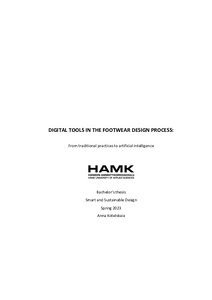Digital tools in the footwear design process: from traditional practices to artificial intelligence
Kotelskaia, Anna (2023)
Kotelskaia, Anna
2023
All rights reserved. This publication is copyrighted. You may download, display and print it for Your own personal use. Commercial use is prohibited.
Julkaisun pysyvä osoite on
https://urn.fi/URN:NBN:fi:amk-202303314502
https://urn.fi/URN:NBN:fi:amk-202303314502
Tiivistelmä
This thesis examines the challenges of introducing a digital approach into the footwear design process. There have been significant improvements in the quality of footwear design programs in recent years. Many companies have already adopted the new digital tools into their designs, while others are still preparing for them to be implemented. According to this thesis, the contribution of 3D software could be a useful tool in helping to solve the challenges inherent in traditional design and development workflows.
The main focus of this thesis is to explore the use of digital tools in the footwear design process. This thesis is the result of research concerning digital products' role in the footwear industry. The objective of the thesis is to determine the differences between the traditional way and the new digital way of designing footwear.
Research methods used in this study are primarily based on the review of online resources on digital footwear design and the review of professional literature. The study covers the main concepts and terms of the digital footwear design process, as well as the traditional footwear design process and its acceptance of digitalization.
In order to be able to build a conclusion on the main proposition of the study, the practical part of the study aims to test the theory introduced. The implementation part of the project involves conducting own research: interviews with professionals. This is designed to understand the strengths and weaknesses of each methodology in terms of its application and result. The practical part presents the case study as well where the digital tools were applied to the design process of a shoe. The main goal is to examine the possibility of creating the footwear concept fully digitally, and explain how digital tools affect the design process and the key benefits of using them within the design process through the case presented.
A study's final result is the conclusion based on the research, analysis, and case study carried out. The comparison of traditional and digital ways of designing footwear is made to show how digital tools can add value to the design process.
The main focus of this thesis is to explore the use of digital tools in the footwear design process. This thesis is the result of research concerning digital products' role in the footwear industry. The objective of the thesis is to determine the differences between the traditional way and the new digital way of designing footwear.
Research methods used in this study are primarily based on the review of online resources on digital footwear design and the review of professional literature. The study covers the main concepts and terms of the digital footwear design process, as well as the traditional footwear design process and its acceptance of digitalization.
In order to be able to build a conclusion on the main proposition of the study, the practical part of the study aims to test the theory introduced. The implementation part of the project involves conducting own research: interviews with professionals. This is designed to understand the strengths and weaknesses of each methodology in terms of its application and result. The practical part presents the case study as well where the digital tools were applied to the design process of a shoe. The main goal is to examine the possibility of creating the footwear concept fully digitally, and explain how digital tools affect the design process and the key benefits of using them within the design process through the case presented.
A study's final result is the conclusion based on the research, analysis, and case study carried out. The comparison of traditional and digital ways of designing footwear is made to show how digital tools can add value to the design process.
